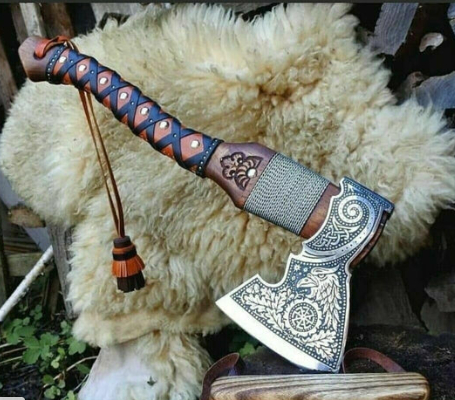Presentation
Viking axes are not simply weapons of war; they are meaningful of a culture saturated with craftsmanship, utility, and creativity. These uncommon devices filled different needs, from wild battle on front lines to regular undertakings in Norse families. The craftsmanship behind Viking axes mirrors a profound comprehension of metallurgy and plan, exhibiting the inventiveness of the Viking public. This article investigates the set of experiences, types, craftsmanship, and present day importance of these momentous axes, revealing insight into their importance past simple weaponry.
Verifiable Foundation of Viking Axes
The Viking Age
The Viking Age, crossing from roughly 793 to 1066 Promotion, denoted a significant period in European history described by Norse investigation, exchange, and striking. During this time, the Vikings laid down a good foundation for themselves as champions as well as talented skilled workers and dealers. The hatchet turned into a focal device in Viking society, assuming a basic part in both battle and day to day existence. Its plan developed close by the requirements of the Vikings, mirroring their versatile nature in different conditions.
Social Importance
Axes were more than instruments; they held huge social and social worth among the Vikings. They were frequently connected with grit and strength, representing a hero’s status. Moreover, tomahawks assumed a part in customs and folklore, building up their significance inside the Norse perspective. The hatchet was a weapon as well as an image of force and esteem, delineating the duality of its presence in Viking society.
Types of Viking Axes
Battle Axes
Battle axes, often characterized by their larger size and heavier heads, were designed for combat. These axes featured sharp, wide blades capable of inflicting serious damage. One notable example is the Dane axe, known for its long handle and broad, curved blade. This design allowed for powerful swings and effective thrusts, making it a favored weapon among Viking warriors. The battle axe’s intimidating appearance and lethal effectiveness cemented its status on the battlefield.
Utility Axes
In contrast to battle axes, utility axes were smaller and designed for practical use. These axes were used for tasks such as chopping wood, building, and crafting. The versatility of utility axes made them indispensable in daily life. Viking households often had several utility axes, each tailored to specific tasks. The designs of these axes prioritized balance and functionality, ensuring they could perform various jobs efficiently.
Decorative Axes
Beyond their functional uses, some Viking axes were created as decorative pieces, often intricately designed and embellished. These axes served as status symbols or ceremonial items, reflecting the owner’s wealth and taste. Decorative axes frequently featured engravings, inlays, and artistic motifs, showcasing the skill of the craftsmen who created them. Such pieces were not meant for combat but rather as representations of artistry and craftsmanship.
Craftsmanship and Materials
Fashioning Strategies
The fashioning system of Viking axes was fastidious and work escalated. Metalworkers would warm press and steel in a produce, pounding it into shape while cautiously controlling the temperature to guarantee ideal strength and adaptability. The strategy of example welding, which included layering various sorts of steel and iron, took into consideration the formation of edges that were sharp as well as tough. This technique created wonderful examples on the sharp edge, improving its tasteful allure while building up its primary honesty.
Materials Utilized
The essential materials utilized in Viking axes were iron and steel. While iron was plentiful, the Vikings likewise figured out how to make steel by adding carbon to press, which altogether worked on its hardness and cutting skill. A few tomahawks consolidated bronze, especially in prior Viking periods. The selection of materials affected the axes exhibition and life span, with talented metalworkers frequently testing to accomplish the best outcomes.
The Development of Axe Plan
As the Viking Age advanced, so too did the plan of tomahawks. Early axes were basic and utilitarian, however as craftsmanship progressed, so did the intricacy and masterfulness of these instruments. The presentation of new methods and materials took into consideration more particular plans. By the late Viking Age, axes started to highlight more intricate heads, longer handles, and further developed balance, upgrading their adequacy both in fight and as apparatuses.
Symbolism and Mythology
Axes were deeply embedded in Norse mythology and symbolism. The Norse god Thor, known for wielding the mighty hammer was often associated with axes as symbols of strength and protection. In various sagas, axes represented not only physical power but also the divine right of warriors to protect their people. The imagery of axes in Viking art and jewelry further emphasizes their significance in Norse culture, making them potent symbols of identity and heritage.
The Cutting edge Restoration of Viking Axes
In contemporary times, there has been a resurgence of interest in Viking society, including their craftsmanship and weaponry. Present day craftsman and smithies have started to reproduce Viking axes, joining conventional methods with contemporary plan sensibilities. These tomahawks are frequently pursued by gatherers, reenactors, and lovers, filling in as utilitarian apparatuses and enhancing pieces that observe Viking legacy. The recovery not just gives proper respect to the craftsmanship of the past yet in addition moves new ages to appreciate and investigate Viking history.
End
Viking axes are striking relics that exemplify the double idea of their makers: wild heroes and talented skilled workers. From their utilitarian jobs in fight and day to day existence to their social imagery, these tomahawks recount an account of a general public that esteemed strength, creativity, and common sense. The persevering through tradition of Viking axes keeps on resounding today, helping us to remember the inventiveness and craftsmanship that characterized the Viking Age. As we investigate their set of experiences and importance, we gain a more profound appreciation for the phenomenal individuals who molded how we might interpret craftsmanship and weaponry.







